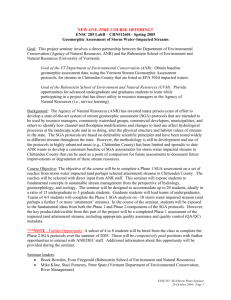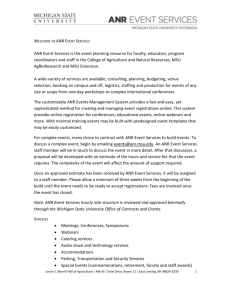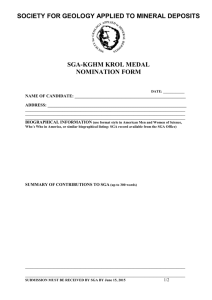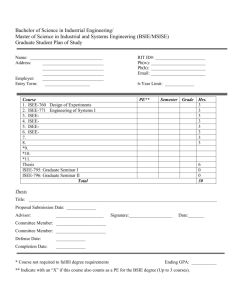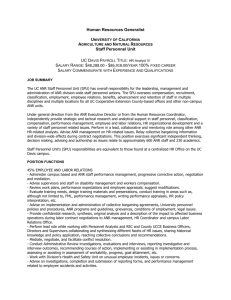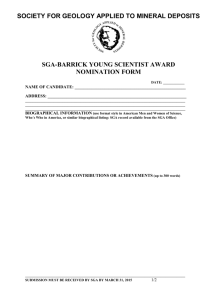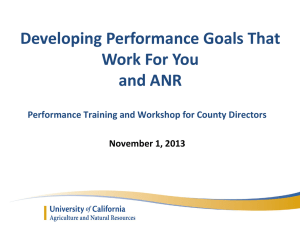Prospectus for Geomorphic Assessment of Storm Water
advertisement
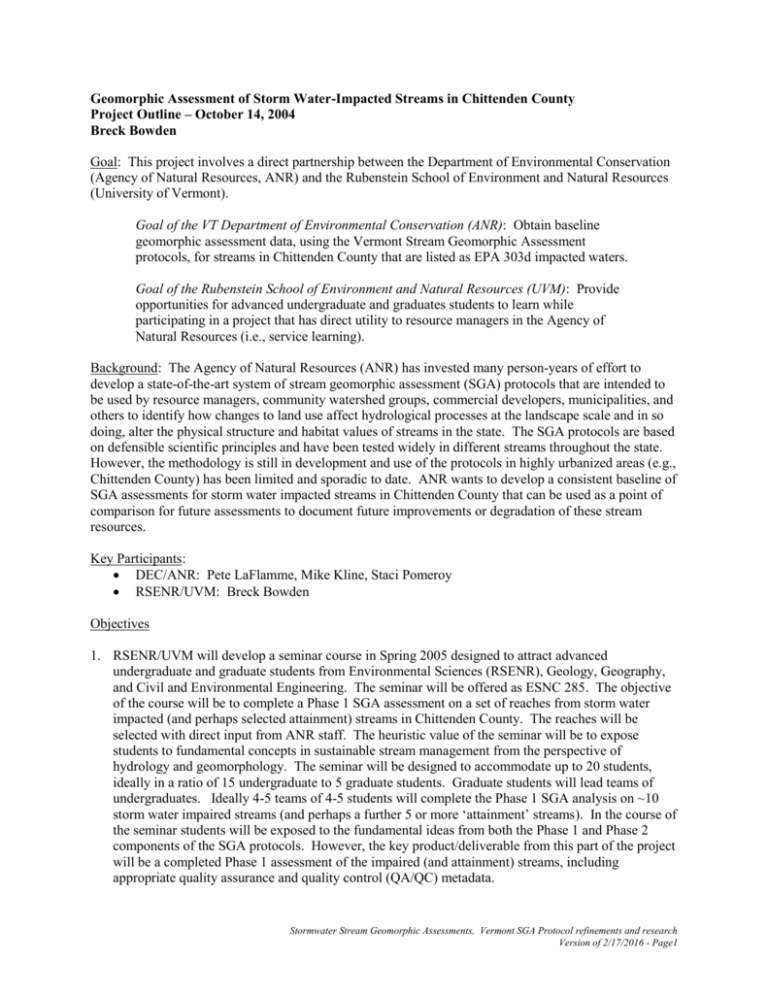
Geomorphic Assessment of Storm Water-Impacted Streams in Chittenden County Project Outline – October 14, 2004 Breck Bowden Goal: This project involves a direct partnership between the Department of Environmental Conservation (Agency of Natural Resources, ANR) and the Rubenstein School of Environment and Natural Resources (University of Vermont). Goal of the VT Department of Environmental Conservation (ANR): Obtain baseline geomorphic assessment data, using the Vermont Stream Geomorphic Assessment protocols, for streams in Chittenden County that are listed as EPA 303d impacted waters. Goal of the Rubenstein School of Environment and Natural Resources (UVM): Provide opportunities for advanced undergraduate and graduates students to learn while participating in a project that has direct utility to resource managers in the Agency of Natural Resources (i.e., service learning). Background: The Agency of Natural Resources (ANR) has invested many person-years of effort to develop a state-of-the-art system of stream geomorphic assessment (SGA) protocols that are intended to be used by resource managers, community watershed groups, commercial developers, municipalities, and others to identify how changes to land use affect hydrological processes at the landscape scale and in so doing, alter the physical structure and habitat values of streams in the state. The SGA protocols are based on defensible scientific principles and have been tested widely in different streams throughout the state. However, the methodology is still in development and use of the protocols in highly urbanized areas (e.g., Chittenden County) has been limited and sporadic to date. ANR wants to develop a consistent baseline of SGA assessments for storm water impacted streams in Chittenden County that can be used as a point of comparison for future assessments to document future improvements or degradation of these stream resources. Key Participants: DEC/ANR: Pete LaFlamme, Mike Kline, Staci Pomeroy RSENR/UVM: Breck Bowden Objectives 1. RSENR/UVM will develop a seminar course in Spring 2005 designed to attract advanced undergraduate and graduate students from Environmental Sciences (RSENR), Geology, Geography, and Civil and Environmental Engineering. The seminar will be offered as ESNC 285. The objective of the course will be to complete a Phase 1 SGA assessment on a set of reaches from storm water impacted (and perhaps selected attainment) streams in Chittenden County. The reaches will be selected with direct input from ANR staff. The heuristic value of the seminar will be to expose students to fundamental concepts in sustainable stream management from the perspective of hydrology and geomorphology. The seminar will be designed to accommodate up to 20 students, ideally in a ratio of 15 undergraduate to 5 graduate students. Graduate students will lead teams of undergraduates. Ideally 4-5 teams of 4-5 students will complete the Phase 1 SGA analysis on ~10 storm water impaired streams (and perhaps a further 5 or more ‘attainment’ streams). In the course of the seminar students will be exposed to the fundamental ideas from both the Phase 1 and Phase 2 components of the SGA protocols. However, the key product/deliverable from this part of the project will be a completed Phase 1 assessment of the impaired (and attainment) streams, including appropriate quality assurance and quality control (QA/QC) metadata. Stormwater Stream Geomorphic Assessments, Vermont SGA Protocol refinements and research Version of 2/17/2016 - Page1 2. As soon as possible after the end of the academic year (early May 2004), ANR staff and RSENR faculty will select – ideally on a competitive basis – a subset of the students to participate in summer internships, sponsored by ANR, to complete Phase 2 field assessments of the SGA protocols. This effort will require several sub-objectives: a. As soon as possible after the academic semester concludes, ANR staff and RSENR faculty will hold a training workshop to ensure that all participants in the summer intern program are trained to an equivalent standard and to coordinate the field logistics for the participating student teams. b. Teams of students, ideally lead by a graduate student Team Leader, will complete Phase 2 assessments on the streams employed in the Phase 1 assessments completed earlier. c. The student teams, ANR staff and RSENR faculty will ensure that the final Phase 1 and Phase 2 SGA data and QA/QC documentation are summarized in appropriate files and turned over to ANR in a timely manner. Ideally this phase of the work would be completed by the end of August 2005. However, weather and other unforeseen factors could delay this delivery. Students who participated in the project and were returning in September would complete data reduction during the Fall 2005 semester, if need be. 3. One graduate student will be funded by ANR as a Project Manager to oversee the entire data collection process and to coordinate the field work. This person will identify a personal research project directly related to the evolving needs of the SGA protocol development. Specifically, the student would focus on some aspect of storm water runoff and it’s effects on stream geomorphology. 4. ANR and RSENR will plan for a co-sponsored workshop series focused on sustainable river management. The workshop series will be aimed jointly at continuing education of ANR staff, its resource partners, and graduate plus advanced undergraduate training of UVM students. ANR and RSENR will separately and jointly seek funding to bring national experts to the Waterbury and UVM campuses for a series of weekly workshops over one semester, most likely Spring 2006 or Fall 2006. ANR and RSENR will also jointly pursue publication of the book based on the information presented in this workshop series. The audience for this book would be land and water managers in the Northeast. Deliverables 1. By 15 November 2004: a memo of understanding based on this prospectus. 2. By 1 January 2004: a contract or other mechanism to formalize funding arrangements. 3. By 1 January 2005: a syllabus for the ESNC 285 seminar 4. By 15 April 2005: Completion of selection of students for the Phase 2 summer field internships. 5. By 15 April 2005: Begin work on joint seminar series planning. 6. By 7 May 2005: completion of the ESNC 285 seminar and delivery of the Phase 1 databases and QA/QC metadata for selected streams in Chittenden County. 7. By 31 May 2005: completion of a field training course Stormwater Stream Geomorphic Assessments, Vermont SGA Protocol refinements and research Version of 2/17/2016 - Page2 8. By 31 August 2005: completion of Phase 2 field work. Ideally, the associated database management and QA/QC will have been completed by this date as well. However, these latter tasks might require more time. If so, they will be completed by 30 November 2005. 9. By 31 October 2005: Complete graduate student research proposal associated with SGA storm water work. 10. By 1 January 2006: Begin joint seminar. 11. By 31 June 2006: Complete joint seminar. 12. By 1 December June 2006: Complete SGA/Storm water graduate student project. Complete draft of book based on seminar Responsibilities ANR and RSENR: Partnership in all aspects of this prospectus ANR: Participation in the NR 285 seminar, especially in introduction, periodic data checking, and at conclusion. Occasional (2-4 lectures). Funding for internships and one or two graduate student positions. First position will be for Project Management of the SGA Phase 1 and Phase 2 work, plus development of a personal project focused on furtherance of the SGA protocols with respect to storm water management. The second will be for development of the joint ANR/RSENR seminar. Joint participation in the ANR/RSENR continuing education workshop series. RSENR: Organization of the ENSC 285 seminar series including syllabus, enrollment, room allocation, media resources, etc. Management of the participating students. Overall organization of the seminar content. Overall management of the student teams, lead by the Graduate Project Manager. Delivery of the Phase 1 databases and QA/QC. Co-management of summer 2005 Phase 2 field work including the training workshop. Delivery of the Phase 2 databases and QA/QC. All academic matters pertaining to the graduate student(s). Co-leadership in development of the continuing education workshop series. Participation in the continuing education workshop series and management of all aspects of UVM student participation in the series. Co-leadership in development of the book evolving from the workshop. Stormwater Stream Geomorphic Assessments, Vermont SGA Protocol refinements and research Version of 2/17/2016 - Page3
